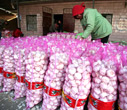Highlights
Walking among dinosaurs
By Dan Chinoy (China Daily)
Updated: 2009-11-24 10:00
One of the reasons western Liaoning is so rich in fossils, scientists say, is the combination of ancient lakes, swamps and mud, as well as nearby volcanoes, that made the area exceptionally good for fossilization.
"The key component in fossilization is (the body) must be deprived of oxygen within 24 hours," Leloup said
There are two ways this could happen: An animal could fall into water and be buried in mud, or could be buried under volcanic ash. If an animal is not buried, the oxygen aids chemical reactions that quickly lead to decay.
Exposed or unprotected remains are also easily destroyed by the weather and scavenging animals, he said.
It is not clear exactly how the feathers were preserved, but most scientists believe the unusually good conditions for fossilization in the Jehol Biota - conditions that were likely rare outside of what is now Northeast China - played an important role.
Along with a remarkable bounty of fossils, including turtles, birds and fish, scientists have identified a host of feathered dinosaur species in the region since Li found sinosauropteryx.
"With all those species, you have a relatively clear picture showing how feathers started from a very primitive, very simple structure to a very complex structure," said Xu Xing, a paleontologist at the Institute of Vertebrate Paleontology and Paleoanthropology in Beijing and an expert on feathered dinosaurs.
Some of the oldest feathered dinosaurs, such as beipiaosaurus, a 2-m-tall beaked theropod, had primitive downy feathers, which scientists think were used for insulation. Others, like caudipteryx, which was about the size of a peacock, had unusual tail feathers that may have been used to attract mates or scare predators.
Microraptor, a small dinosaur descended from velociraptor, a vicious predator made famous by the Hollywood movie Jurassic Park, also had sophisticated, asymmetrical feathers similar to modern birds.
"From the fossil structure, from the bones, if you compare dinosaurs and fossils, including archaeopteryx and sinosauropteryx, they comprise a series - you can see the fossils slowly change," said paleontologist Ji Shu'an.
The wide variety of feathered dinosaurs in Liaoning has also led some scientists to speculate that feathers were a more common feature of dinosaurs. "This implied that maybe all relatively recent dinosaurs had feathers. It wasn't just one dinosaur or one species of dinosaur," said Ji.
While it is not clear exactly what would create feathers, some experiments have shown that artificially blocking a certain signaling molecule in chickens led to the development of webbed feet and turned scales on their legs into feathers. A similar process may have happened naturally in dinosaurs, changing scales into feathers.
This would have given them a vital evolutionary advantage, according to Hu Dongyu, a professor of paleontology at Shenyang Normal University.
"The most important function of early feathers was probably insulation," he said and explained that a feathered dinosaur would not have to expend as much energy to keep warm and could instead focus on catching more prey, which would have enabled it to be a more successful species. The fact feathers were later useful for flight was initially probably just a coincidence.












